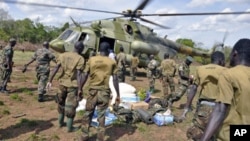A six-month effort to eliminate LRA rebels in Central Africa is being criticized for failing to make meaningful progress. A coalition of humanitarian and rights groups says the joint United Nations / African Union effort lacks urgency and resources.
The NGOs have released a new report prior to a December 18th U.N. Security Council meeting on the Lord’s Resistance Army.
The LRA has its roots in Uganda, where it took up arms against the government 26 years ago. It’s now believed to be made up of a dozen or so smaller groups operating in the Democratic Republic of Congo and neighboring countries. Some reports have said leader Joseph Kony is now based in Darfur and may have the support of the Sudanese military. He and others are wanted by the International Criminal Court.
While M23 rebels have received much attention for their recent offensive in the eastern DRC, LRA rebels have long been blamed for killings, child abductions, rapes and looting of villages.
“On the whole efforts to hunt down the LRA continue to make some progress, but we’ve been quite disappointed in the lack of leadership shown by the United Nations. They put out a strategy six months ago that details a very comprehensive response to the situation that’s exactly what’s needed. And yet almost none of that strategy has actually been implemented in that time,” said Michael Poffenberger, Executive Director of the NGO Resolve.
The strategy includes many components.
“Including a military component that works with the African Union to coordinate regional military efforts; a humanitarian and peace building component that helps develop infrastructure and deliver basic necessities for the communities that the most affected. It includes a component that tries to get LRA members to defect using radio broadcasts and flyers. It includes a component to try and improve protection of civilians in the regions,” he said.
Poffenberger said the strategy has faced a number of impediments.
“I would say the biggest has been the lack of cooperation from the government of Congo and the government of Sudan, in particular, who really have just refused to acknowledge the nature of the LRA issue within their countries. With Sudan itself, reports indicating that they may actually be sheltering some LRA fighters within their territory,” he said.
Another impediment, he said, is a lack of resources.
“One of the big points of the strategy was to show donors where they can be investing to help communities that are being affected by the LRA. And that hasn’t happened yet. The U.N. hasn’t come up with the list of projects that need to be funded. And as a result the donors have not put any new resources into the region,” he said.
The Resolve executive director said the recent offensive by M23 in eastern DRC has drawn attention and resources from the campaign against the LRA.
The NGOs’ report does have some bright spots. It praised U.S. military advisers in the region that are aiding Ugandan troops. It also said there have been a number of high-level LRA defections in recent months.
The NGOs have released a new report prior to a December 18th U.N. Security Council meeting on the Lord’s Resistance Army.
The LRA has its roots in Uganda, where it took up arms against the government 26 years ago. It’s now believed to be made up of a dozen or so smaller groups operating in the Democratic Republic of Congo and neighboring countries. Some reports have said leader Joseph Kony is now based in Darfur and may have the support of the Sudanese military. He and others are wanted by the International Criminal Court.
While M23 rebels have received much attention for their recent offensive in the eastern DRC, LRA rebels have long been blamed for killings, child abductions, rapes and looting of villages.
“On the whole efforts to hunt down the LRA continue to make some progress, but we’ve been quite disappointed in the lack of leadership shown by the United Nations. They put out a strategy six months ago that details a very comprehensive response to the situation that’s exactly what’s needed. And yet almost none of that strategy has actually been implemented in that time,” said Michael Poffenberger, Executive Director of the NGO Resolve.
The strategy includes many components.
“Including a military component that works with the African Union to coordinate regional military efforts; a humanitarian and peace building component that helps develop infrastructure and deliver basic necessities for the communities that the most affected. It includes a component that tries to get LRA members to defect using radio broadcasts and flyers. It includes a component to try and improve protection of civilians in the regions,” he said.
Poffenberger said the strategy has faced a number of impediments.
“I would say the biggest has been the lack of cooperation from the government of Congo and the government of Sudan, in particular, who really have just refused to acknowledge the nature of the LRA issue within their countries. With Sudan itself, reports indicating that they may actually be sheltering some LRA fighters within their territory,” he said.
Another impediment, he said, is a lack of resources.
“One of the big points of the strategy was to show donors where they can be investing to help communities that are being affected by the LRA. And that hasn’t happened yet. The U.N. hasn’t come up with the list of projects that need to be funded. And as a result the donors have not put any new resources into the region,” he said.
The Resolve executive director said the recent offensive by M23 in eastern DRC has drawn attention and resources from the campaign against the LRA.
The NGOs’ report does have some bright spots. It praised U.S. military advisers in the region that are aiding Ugandan troops. It also said there have been a number of high-level LRA defections in recent months.






